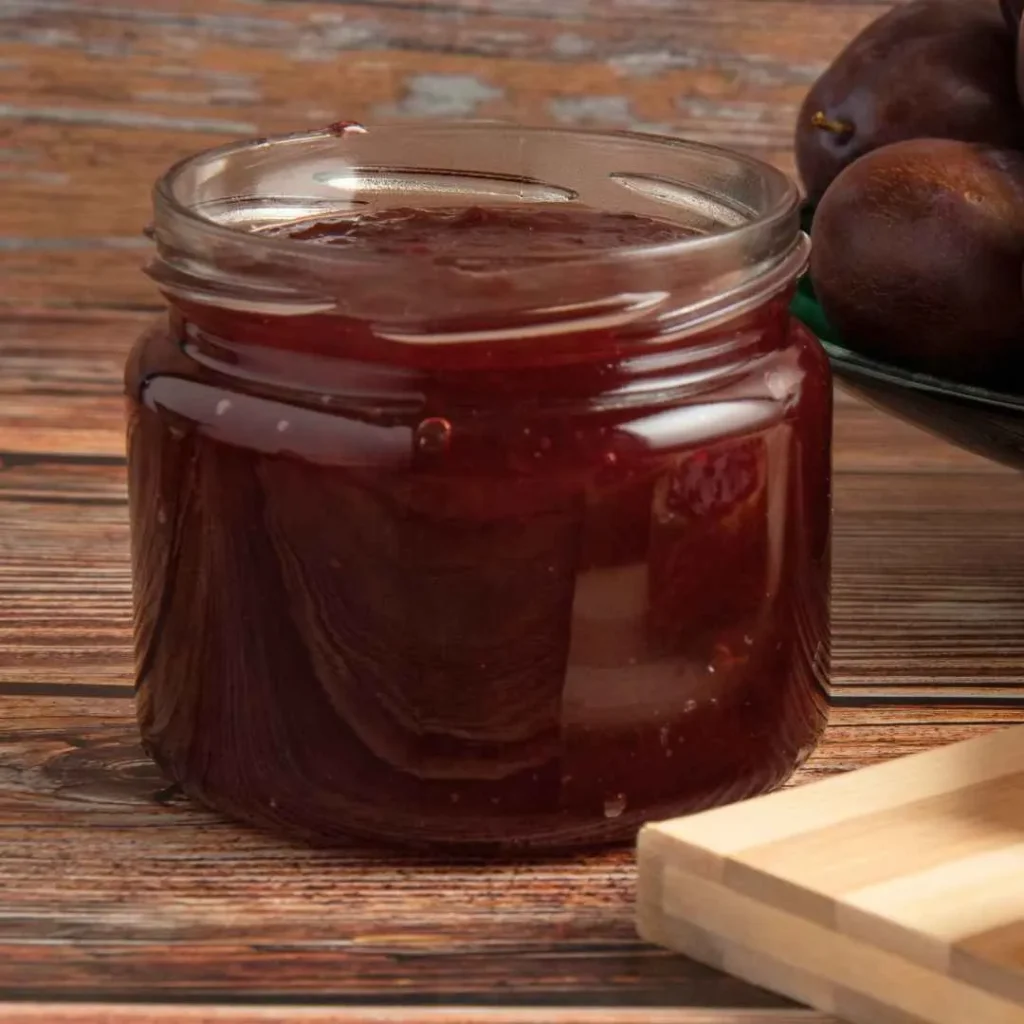Making your own plum jam is a delightful way to enjoy the sweet taste of summer all year round. With just a few simple ingredients and some easy steps, you can create a delicious spread that is perfect for toast, desserts, or even savory dishes. This guide will walk you through everything you need to know to make your own plum jam from scratch, ensuring you get the best flavor and texture possible.
Key Takeaways
- Select ripe plums for the best flavor in your jam.
- Macerate plums overnight to enhance sweetness and reduce cooking time.
- Use a wide pot to cook the jam evenly and prevent scorching.
- Test for doneness using a cold spoon to check the jam’s thickness.
- Store jam in sterilized jars for long-lasting freshness.
Selecting the Right Plums for Your Jam
When making plum jam, choosing the right plums is crucial for the best flavor and texture. Here are some tips to help you select the perfect plums:
Choosing the Best Plum Varieties
- Look for red plums, Victoria plums, or damsons as they are known to make excellent jam.
- Avoid plums that are too firm; they should be soft and slightly overripe for the best results.
- Check for any bruising or blemishes, as these can spoil your jam.
Why Ripeness Matters
- Ripe plums have more natural sugars, which means you can use less added sugar in your jam.
- Overripe plums can be used, but make sure they are not spoiled. They should feel soft, like a water balloon, when you touch them.
- The flavor of your jam will be much better if you use plums that are at their peak ripeness.
Where to Source Quality Plums
- Farmers markets are a great place to find fresh, ripe plums. Look for crates of overripe fruit that may be discounted.
- If you have access to a plum tree, pick the ones that have fallen to the ground, as they are usually the ripest.
- Always inspect the plums for any signs of spoilage before purchasing.
Essential Ingredients for Plum Jam
Making delicious plum jam requires a few key ingredients that work together to create the perfect spread. Here’s what you need to know:
The Role of Sugar in Jam Making
Sugar is essential in jam making for several reasons:
- Sweetness: It balances the tartness of the plums.
- Preservation: Sugar helps to preserve the jam, extending its shelf life.
- Texture: It contributes to the jam’s consistency, helping it to set properly.
For a balanced flavor, aim for about 1.5 pounds of sugar for every 4 pounds of plums. Too much sugar can make the jam overly sweet, so adjust according to the ripeness of your fruit.
Using Pectin for Perfect Consistency
Pectin is a natural thickening agent found in fruits. It’s crucial for achieving the right texture in your jam. Here’s how to use it:
- Choose the Right Pectin: Look for low-sugar or universal pectin options.
- Follow Instructions: Each brand has specific instructions for use, so read the label carefully.
- Combine with Calcium: Some pectins require calcium to activate, which helps in setting the jam without excessive sugar.
The Importance of Lemon Juice
Lemon juice is not just for flavor; it plays a vital role in the jam-making process:
- Acidity: It helps balance the sweetness of the plums.
- Pectin: It adds extra pectin, which aids in setting the jam.
- Safety: The acidity helps preserve the jam, making it safe for long-term storage.
By understanding these essential ingredients, you can create a delicious plum jam that’s perfect for spreading on toast or using in your favorite recipes!
Preparing Your Plums for Jam
How to Pit and Quarter Plums
To start making your homemade plum jam, you need to pit and quarter your plums. If you have loose-stone plums, simply cut them in half and twist to remove the pit. For clingstone varieties, slice down one side of the plum and carefully cut around the pit to remove it. After pitting, cut the halves into quarters or smaller pieces if you prefer a smoother jam.
Macerating Plums Overnight
Once your plums are prepared, place them in a large bowl and add sugar. A good rule of thumb is to use about 1.5 pounds of sugar for every 4 pounds of plums. Cover the bowl with plastic wrap and refrigerate overnight. This process, known as maceration, helps draw out the juices and makes cooking easier.
The Benefits of Keeping Plum Skins
Don’t forget to keep the skins on your plums! The skins add rich color and flavor to your jam. They also contain natural pectin, which helps with the jam’s consistency. So, when you’re preparing your plums, remember that those skins are your friends!
By following these steps, you’ll be well on your way to creating delicious plum jam that you can enjoy for months to come!
Cooking Your Plum Jam to Perfection
The Best Cookware for Jam Making
To make the best plum jam, you need the right cookware. Here are some options:
- Wide Dutch Oven: Great for even heat distribution.
- Sauté Pan: Perfect for smaller batches.
- Heavy-Bottomed Pot: Helps prevent scorching.
Stirring Techniques to Avoid Scorching
When cooking your jam, stirring is crucial. Here are some tips:
- Use a long-handled wooden spoon to stir.
- Stir frequently to keep the jam from sticking.
- Scrape the bottom of the pot to prevent burning.
Remember: A good stirring technique can make a big difference in the final taste of your jam.
Testing Jam for Doneness
To know when your jam is ready, you can use the following methods:
- Wrinkle Test: Place a small amount on a chilled plate. If it wrinkles when pushed, it’s done.
- Thermometer Method: Use a sugar thermometer. When it reads 220°F (104°C), your jam is ready.
- Spoon Test: Dip a spoon into the jam; if it clings, it’s close to being done.
Storing and Preserving Your Plum Jam
Once you’ve made your delicious plum jam, it’s important to store it properly to keep it fresh and tasty. Here are some key steps to follow:
Sterilizing Jars for Preservation
- Start by washing your jars and lids with warm, soapy water.
- Place the jars in the oven at 215°F for about 20 minutes to sterilize them.
- Boil the lids for 5 minutes to ensure they are clean.
Canning Methods for Long-Term Storage
To keep your jam shelf-stable, you can use the water-bath canning method:
- Fill your sterilized jars with hot jam, leaving about 1/2 inch of space at the top.
- Screw the lids on tightly but not too tight, allowing air bubbles to escape.
- Place the jars in a canning pot and cover them with 1-2 inches of water.
- Bring to a boil and process for 10-15 minutes, depending on your altitude.
- After processing, let the jars cool at room temperature for 12-24 hours.
Refrigeration and Freezer Options
If you prefer not to can your jam, you can store it in the refrigerator:
- Refrigerate opened jars and consume within a few weeks.
- For longer storage, consider freezing your jam in airtight containers. It can last up to a year in the freezer.
Creative Uses for Plum Jam
Plum jam is not just a delicious spread; it can elevate many dishes! Here are some creative ways to enjoy your homemade jam:
Pairing Plum Jam with Savory Dishes
- Glaze for Meats: Use plum jam as a glaze for roasted pork or chicken. It adds a sweet and tangy flavor that complements the meat.
- Sauce for Cheese: Serve plum jam alongside a cheese platter. It pairs wonderfully with sharp cheeses like cheddar or blue cheese.
- Dressing for Salads: Mix plum jam with olive oil and vinegar to create a unique salad dressing.
Baking with Plum Jam
- Fill Pastries: Use plum jam as a filling for pastries or tarts. It adds a fruity burst to your baked goods.
- Swirl in Muffins: Add a spoonful of plum jam to muffin batter before baking for a sweet surprise.
- Top Desserts: Drizzle plum jam over ice cream or yogurt for a refreshing dessert.
Plum Jam as a Breakfast Staple
- Spread on Toast: The classic way to enjoy plum jam is on toast or bagels. It’s a perfect breakfast treat!
- Pancake Topping: Use plum jam instead of syrup on pancakes or waffles for a fruity twist.
- Mix into Oatmeal: Stir a spoonful of plum jam into your morning oatmeal for added flavor.
Troubleshooting Common Jam-Making Issues
Making plum jam can be a fun and rewarding experience, but sometimes things don’t go as planned. Here are some common problems you might face and how to fix them.
Fixing Runny Jam
If your jam turns out runny, it might not have cooked long enough or you may not have used enough pectin. Here’s what you can do:
- Re-cook the jam: Pour the runny jam back into a pot and bring it to a boil again.
- Add more pectin: Mix a small amount of pectin with sugar and stir it into the boiling jam.
- Cook longer: Keep cooking until it reaches the right thickness.
Preventing Crystallization
Crystallization can happen if there’s too much sugar or if the jam cools too quickly. To avoid this:
- Stir constantly: While cooking, make sure to stir the jam to keep the sugar dissolved.
- Use a clean jar: Make sure your jars are clean and dry before filling them.
- Cool slowly: Let the jam cool at room temperature instead of in the fridge.
Dealing with Overcooked Jam
If your jam is too thick or burnt, it can be disappointing. Here’s how to handle it:
- Add water: If it’s too thick, you can add a little water and reheat it gently.
- Use it differently: If it’s burnt, consider using it as a glaze for meats or in baking instead of spreading it on toast.
- Learn for next time: Keep an eye on the cooking time and temperature to avoid overcooking.
Final Thoughts on Making Plum Jam
Making your own plum jam is not just a fun project; it’s a way to enjoy the sweet taste of summer all year long. With just a few simple steps, you can create a delicious treat that’s way better than store-bought versions. Remember, the key is to use ripe plums and let them sit with sugar overnight to bring out their natural juices. Once you’ve cooked your jam, you can store it in jars or even keep it in the fridge for a quick snack. Whether you spread it on toast, use it in desserts, or enjoy it with savory dishes, your homemade plum jam will surely impress everyone. So, gather your ingredients and start jamming!
Frequently Asked Questions
What type of plums should I use for jam?
It’s best to pick very ripe plums, like red or black plums. They should be soft and juicy for the best flavor.
Do I need to peel the plums before making jam?
No, you don’t need to peel them! The skins add flavor and help the jam set.
How long can I store homemade plum jam?
If canned properly, you can store it for up to a year. In the fridge, it lasts about a month.
Can I use less sugar in the jam?
Yes, you can reduce the sugar, but it might affect the jam’s texture. You may need to add pectin to help it set.
What can I do if my jam is too runny?
You can cook it a bit longer to thicken it up. Just keep stirring to prevent burning.
How can I use plum jam besides spreading it on toast?
You can use it in baking, as a topping for desserts, or even in savory dishes like glazes for meats.



